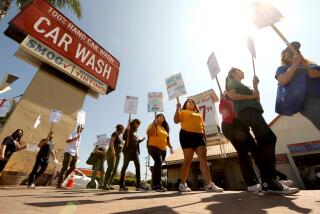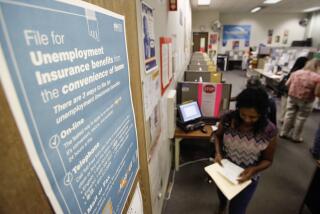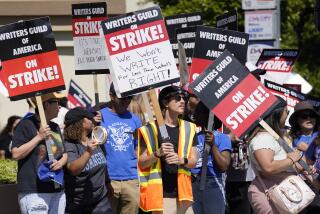Time to Reform Jobless Benefits
Unemployment is much in the news of late, yet the state unemployment insurance program operates pretty much invisibly.
That will change soon enough, because all this unemployment is consuming benefits in record amounts. The California unemployment insurance surplus is expected to shrink by 50%, to $2.7 billion, by 1994 from a base of December, 1990. The total payout in that period: $10.6 billion.
Since benefits are funded entirely by levies on employers, if you’re in business in California, you’re looking at higher taxes. Employers in this state will pay an extra $477 million in unemployment taxes this year, and another $796 million next year, for a total of nearly $1.3 billion in additional levies to keep the benefits flowing.
These are hefty increases, given that total employer contributions in 1991 were just $1.5 billion. The average tax rate, charged to employers on the first $7,000 of each worker’s wages, was 2% then. Next year it will likely be 3.1%.
As usual, the increased business taxes needed to keep the fund solvent will come at the worst possible time. Demand for benefits--and thus, the need for increased levies to pay for them--is always strongest when business is weakest. That, after all, is when layoffs occur. Accordingly, unemployment in California was 9.5% in June.
The state Assembly Ways and Means Committee, meanwhile, is considering legislation to raise the maximum weekly benefit by $20, to $250, which would cost an additional $100 million a year, according to the California Taxpayers Assn., a business group opposed to the increase. Organized labor wanted a much larger hike, on the not-unreasonable premise that California benefits are low. (Last year, only Louisiana and Indiana paid less as a percent of average weekly wages.)
All these developments raise an interesting question. With so much at stake, is this really how the system ought to work?
Well, not exactly. But all the focus on payment and taxation levels obscures the ways in which the system really needs to change.
First, a little background: Unlike many other industrialized states, which pay higher benefits but have tighter eligibility standards, California covers almost the entire work force, but pays less per unemployed worker. This may reflect the traditional importance to California of farming, forestry, canning and perhaps even Hollywood, all of which have a history of seasonality.
Since California makes eligibility relatively easy--all it really takes is $1,300 in earnings in a three-month period--a lot of seasonal workers are covered.
Now, remember that unemployment is insurance, so experience counts; an employer’s propensity to lay off workers is a factor in the employer’s taxes, which are comparable to premiums. The problem is, in California it’s not enough of a factor.
Bruce Meyer, a Northwestern University economist who studies unemployment compensation, says that compared to other states, California is historically worse than average at socking layoff-prone firms with higher taxes.
California employers, for example, are taxed according to a range of rates; the highest is for layoff-prone firms, the lowest for firms that rarely lay off. When the system needs more money for benefits, one of several higher ranges--or schedules--is adopted.
All the schedules have the same top rate. But the gap between the highest rate and the lowest--the price of laying off--grows progressively narrower with each schedule. And as the state needs more money to fund the system, higher schedules are adopted.
By failing to charge a company fully for the people it lets go, the system basically subsidizes layoffs, socializing the cost by penalizing stable firms to cover for those that aren’t stable.
In 1989, for instance, the last full non-recession year, the mining industry contributed $13 million to the state unemployment fund, against $10 million in benefit charges. By contrast, agriculture, forestry and fishing contributed $121 million--against total charges of $215 million.
Not only is this bad for good companies that try to keep their workers. It’s bad for the state’s economy.
“Because you have this system, there is more unemployment than there would be otherwise,” Meyer says. In effect, he says, “we’ve decided we’re going to subsidize industries that lay off a lot of people.”
California also falls down by levying unemployment taxes only on the first $7,000 in pay per worker. A company paying, say, 3% on 10 workers making $7,000 each forks over $2,100--the same as a firm with 10 workers making $70,000 each. So the latter’s effective tax rate is just 0.3%.
Talk about regressive. California unemployment levies penalize firms that employ lots of low-wage workers, saddling often-aspiring businesses with much heftier unemployment taxes as a percentage of payroll. Thirty-six states have a taxable wage base higher than $7,000.
So much for the finance side of the equation. Benefits are a little stickier. A number of studies show that raising benefits increases unemployment. On the other hand, setting benefits too low adds to the misery of the jobless, which we’ve already done by making the benefits taxable. The result, in recent years, is that despite some nominal increases, inflation-adjusted after-tax unemployment benefits have fallen quite a bit.
What’s to be done? There’s no perfect answer, but a couple of ideas might be worth considering. For example, why not compel employers to give workers full pay for the first week or two of any layoff? That would discourage temporary layoffs and provide the most benefit while workers are clearly unemployed through no fault of their own.
Or we could eliminate fixed benefits in favor of a sliding scale, paying the most in the first week, less in the second and so forth. This would create a growing incentive to get a job.
But it would be expensive, since most people collect in the first week but few collect in week 26. And raising benefits early in the process would make more people sign up. Surprising as it may seem, Meyer says, anywhere from 25% to 50% of those eligible for benefits don’t apply for them.
More to Read
Inside the business of entertainment
The Wide Shot brings you news, analysis and insights on everything from streaming wars to production — and what it all means for the future.
You may occasionally receive promotional content from the Los Angeles Times.










